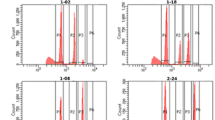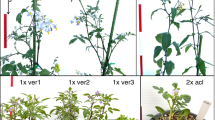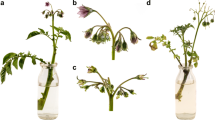Abstract
Manipulation of ploidy in switchgrass has potential to accelerate inbred production and to provide insight about genome structure through either sequencing or cytogenetic approaches. We have identified two dihaploid individuals isolated from among the progeny of a controlled cross between two individuals of the cultivars Alamo and Kanlow. The dihaploid lines were initially distinguished from the parental lines by their reduced heterozygosity and were subsequently confirmed through estimation of C values by flow cytometry and chromosome counts of metaphase root tip squash preparations. These plants are functionally sterile, with floral bracts that remain closed and inviable pollen. They can be easily distinguished from tetraploid individuals by their reduced stature, smaller epidermal cell size, and lower number of chloroplasts per guard cell. Aberrant meiosis in these individuals is evidenced by a lack of regular pairing at diakinesis and metaphase I and suggests that the non-homologous genomes are distinct from one another. The reduced genome size of these dihaploids will facilitate basic genome studies and genetic analyses that are impossible or problematic in polyploid accessions.


Similar content being viewed by others
References
Abak K, Sari N, Paksoy M, Yilmaz H, Aktas H, Tunali C (1996) Genotype response to haploid embryo induction with pollination by irradiated pollens in melon, obtaining of dihaploid lines, determination of haploid and diploid plants by different techniques. Tr J Agric Forestry 20:425–430
Aliscioni SS, Giussani LM, Zuloaga FO, Kellogg EA (2003) A molecular phylogeny of Panicum (Poaceae: Paniceae): tests of monophyly and phylogenetic placement within the Panicoideae. Am J Bot 90:796–821
Arumuganathan K, Earle ED (1991) Estimation of nuclear DNA amounts of plants by flow cytometry. Plant Mol Biol Rep 9:229–241
Barnett F, Carver R (1967) Meiosis and pollen stainability in switchgrass, Panicum virgatum L. Crop Sci 7:301–304
Bennett MD, Bhandol P, Leitch IJ (2000) Nuclear DNA amounts in angiosperms and their modern uses—807 new estimates. Ann Bot 86:859–909
Bradshaw H, Stettler R (1993) Molecular genetics of growth and development in Populus. I. Triploidy in hybrid poplars. Theor Appl Genet 86:301–307
Bowers JE, Chapman BA, Rong J, Paterson AH (2003) Unravelling angiosperm genome evolution by phylogenetic analysis of chromosomal duplication events. Nature 422:433–438
Brownstein MJ, Carpten JD, Smith JR (1996) Modulation of non-templated nucleotide addition by Taq DNA polymerase: primer modifications that facilitate genotyping. Biotechniques 20:1004–1010
Brunken J, Estes J (1975) Cytological variation in Panicum virgatum L. Southwest Nat 4:379–405
Cavalier-Smith T (1985) The evolution of genome size. Wiley, London
Chen D, Ronald P (1999) A rapid DNA miniprepreparation method suitable for AFLP and other PCR application. Plant Mol Biol Rep 17:53–57
Church G (1940) Cytotaxonomic studies in the Gramineae Spartina, Andropogon and Panicum. Am J Bot 27:263–271
Conger B (2002) Development of in vitro systems for switchgrass (Panicum virgatum). Final report for 1992 to 2002 ORNL/SUB-02-11XSY161/01
Dweikat I, Lyrene P (1990) Twin seedlings and haploids in blueberry (Vaccinium spp.). J Hered 81:198–200
Forster B, Heberle-Bors E, Kasha K, Touraev A (2007) The resurgence of haploids in higher plants. Trends Plant Sci 12:368–375
Gould F (1975) The grasses of Texas. Texas A&M University Press, College Station
Hopkins A, Taliaferro C, Murphy C, Christian D (1996) Chromosome number and nuclear DNA content of several switchgrass populations. Crop Sci 36:1192–1195
Hultquist S, Vogel K, Lee D, Arumuganathan K, Kaeppler S (1997) DNA content and chloroplast DNA polymorphisms among switchgrasses from remnant Midwestern prairies. Crop Sci 37:595–598
Jauhar P (1970) Haploid meiosis and its bearing on the phylogeny of pearl millet, Pennisetum typhoides Stapf et Hubb. Genetica 41:532–540
Kasha K, Kao K (1970) High frequency haploid production in barley (Hordeum vulgare L.). Nature 225:874–876
Kaushal P, Malaviya D, Roy A, Pathak S, Agrawal A, Khare A et al (2008) Reproductive pathways of seed development in apomictic guinea grass (Panicum maximum Jacq.) reveal uncoupling of apomixis components. Euphytica 164(1):81–92
Kisana N, Nkongolo K, Quick J, Johnson D (1993) Production of doubled haploids by anther culture and wheat × maize method in a wheat breeding programme. Plant Breeding 110:96–102
Langkjaer RB, Cliften PF, Johnston M, Piskur J (2003) Yeast genome duplication was followed by asynchronous differentiation of duplicated genes. Nature 421:848–852
Le Thierry M, Panaud O, Brown S, Siljak-Yakovlev S, Sarr A (1998) Brief communication: first evaluation of nuclear DNA content in Setaria genus by flow cytometry. J Hered 89:556–559
Lu K, Kaeppler S, Vogel K, Arumuganathan K, Lee D (1998) Nuclear DNA content and chromosome numbers in switchgrass. Great Plains Res 8:269–280
Marks G (1983) Feulgen banding of heterochromatin in plant chromosomes. J Cell Sci 62:171–176
Martínez-Reyna J, Vogel K, Caha C, Lee D (2001) Meiotic stability, chloroplast DNA polymorphisms, and morphological traits of upland lowland switchgrass reciprocal hybrids. Crop Sci 41:1579–1583
Martínez-Reyna J, Vogel K (2002) Incompatibility systems in switchgrass. Crop Sci 42:1800–1805
Martínez-Reyna J, Vogel K (2008) Heterosis in switchgrass: spaced plants. Crop Sci 48:1312–1320
McMillan C, Weiler J (1959) Cytogeography of Panicum virgatum in central North America. Am J Bot 46:590–593
Missaoui AM, Paterson AH, Bouton JH (2005) Investigation of genomic organization in switchgrass (Panicum virgatum L.) using DNA markers. Theor Appl Genet 110:1372–1383
Narasimhamoorthy B, Saha M, Swaller T, Bouton J (2008) Genetic diversity in switchgrass collections assessed by EST-SSR markers. Bioenerg Res 1:136–146
Nielsen E (1944) Analysis of variation in Panicum virgatum. J Agric Res 69:327–353
Pendinen G, Gavrilenko T, Jiang J (2008) Allopolyploid speciation of the Mexican tetraploid potato species Solanum stoloniferum and S. hjertingii revealed by genomic in situ hybridization. Genome 51:714–720
Porter C (1966) An analysis of variation between upland and lowland switchgrass, Panicum virgatum L., in Central Oklahoma. Ecology 47:980–992
Powell JB, Hanna WW, Burton GW (1975) Origin, cytology, and reproductive characteristics of haploids in pearl millet. Crop Sci 15:389–392
Price H, Dillon S, Hodnett G, Rooney W, Ross L, Johnston J (2005) Genome evolution in the genus Sorghum (Poaceae). Ann Bot 95:219–227
Riley R, Vogel K (1982) Chromosome numbers of released cultivars of switchgrass, indiangrass, big bluestem and sand bluestem. Crop Sci 22:1081–1083
Ross W, Wilson J (1969) Polyembryony in Sorghum. Crop Sci 9:842–843
Segui-Simarro J, Nuez F (2008) Pathways to doubled haploidy: chromosome doubling during androgenesis. Cytogenet Genome Res 120:358–369
Taliaferro C, Hopkins A (1996) Breeding characteristics and improvement potential of switchgrass. In: Cundiff JS et al. (eds) Proceedings of the Third Liquid Fuel Conference, Nashville, TN, pp 2–9
Tobias C, Hayden D, Twigg P, Sarath G (2006) Genic microsatellite markers derived from EST sequences of switchgrass (Panicum virgatum L.). Mol Ecol Notes 6:185–187
Tobias CM, Sarath G, Twigg P, Lindquist E, Pangilinan J, Penning BW et al (2008) Comparative genomics in switchgrass using 61,585 high-quality expressed sequence tags. Plant Genome 1:111–124
Toojinda T, Baird E, Booth A, Broers L, Hayes P, Powell W et al (1998) Introgression of quantitative trait loci (QTLs) determining stripe rust resistance in barley: an example of marker-assisted line development. Theor Appl Genet 96:123–131
Tuskan GA, Difazio S, Jansson S, Bohlmann J, Grigoriev I, Hellsten U et al (2006) The genome of black cottonwood, Populus trichocarpa (Torr. & Gray). Science 313:1596–1604
Uozu S, Ikehashi H, Ohmido N, Ohtsubo H, Ohtsubo E, Fukui K (1997) Repetitive sequences: cause for variation in genome size and chromosome morphology in the genus Oryza. Plant Mol Biol 35:791–799
Vogel K, Mitchell R (2008) Heterosis in switchgrass: biomass yield in swards. Crop Sci 48:2159–2164
Yang Z, Gilbert J, Fedak G, Somers D (2005) Genetic characterization of QTL associated with resistance to Fusarium head blight in a doubled-haploid spring wheat population. Genome 48:187–196
Acknowledgments
Supported by a United States Department of Agriculture, Agricultural Research Service, headquarter-funded postdoctoral fellowship to HA Young and by ARS CRIS 9235-21000-013-00D, National Program 213/307, Bioenergy. The US Department of Agriculture, Agricultural Research Service is an equal opportunity/affirmative action employer, and all agency services are available without discrimination. Mention of commercial products and organizations in this manuscript is solely to provide specific information. It does not constitute endorsement by USDA-ARS over other products and organizations not mentioned. We wish to thank James Thompson and Gautam Sarath for critical reading of the manuscript.
Author information
Authors and Affiliations
Corresponding author
Rights and permissions
About this article
Cite this article
Young, H.A., Hernlem, B.J., Anderton, A.L. et al. Dihaploid Stocks of Switchgrass Isolated by a Screening Approach. Bioenerg. Res. 3, 305–313 (2010). https://doi.org/10.1007/s12155-010-9081-7
Published:
Issue Date:
DOI: https://doi.org/10.1007/s12155-010-9081-7




